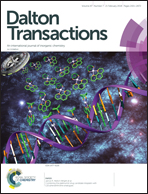A new BODIPY-derived ratiometric senor with internal charge transfer (ICT) effect: colorimetric/fluorometric sensing of Ag+†
Abstract
With a 4-aminostyryl group introduced at its 3-position, a BODIPY BDP-ODTAC was derived as a new ratiometric sensor for Ag+ by modifying 4-amino group as a Ag+ chelator, 1-oxa-4,10-dithia-7-azacyclododecane (ODTAC). In addition to the specific Ag+-induced hypsochromic absorption shift from 606 to 562 nm, this sensor demonstrated an excitation shift from 600 to 560 nm due to the internal charge transfer (ICT) effect endowed by the introduced α-4-aminostyryl group. The Ag+-induced recovery and enhancement of the intrinsic local emission band was also observed. The different sensing behavior of ODTAC-BDP with chelator ODTAC substituting on the meso-phenyl group infers that the ratiometric sensing behavior of BDP-ODTAC is correlated to the amino group in ODTAC acting as the electron donor for the ICT effect. With high Ag+ selectivity over interfering cations such as Hg2+ and Pb2+, BDP-ODTAC displays a fluorometric limit of detection (LOD) of ∼17 nM (∼0.002 ppm), which is distinctly lower than EPA and WHO standards for drinking water (500 nM, ∼0.055 ppm). Moreover, the BDP-ODTAC-doped PVC film shows the Ag+ sensitivity of 1 ppm with a color switch from blue to purple, providing this sensor the ability to determine Ag+ in totally aqueous solution sensitively via naked-eye detection.



 Please wait while we load your content...
Please wait while we load your content...